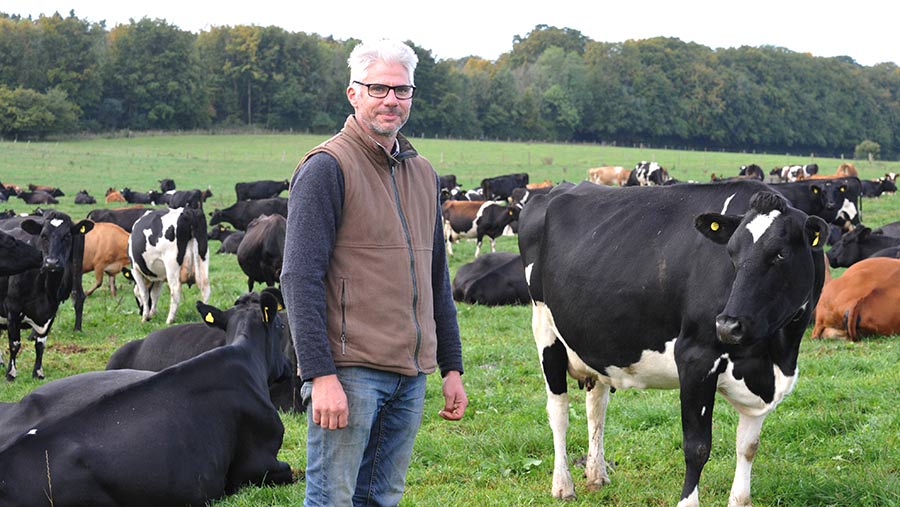How 10 in 7 milking helped work-life balance and cow health
 © Debbie James
© Debbie James One of the biggest challenges for the UK dairy industry is attracting new staff and holding onto them, so when spring milk producer Mark Hoskins had a vacancy in his workforce, he saw it as a good opportunity to trial flexible milking.
He initially opted for a three-in-two pattern and later once-a-day milking for five weeks after calving, but milk yield dropped and, when cows were milked once a day, somatic cells count increased to 200,000 cells/ml.
Moving to a milking pattern of 10 times in seven days for the entire season, with a 16-hour gap in between each milking, has resolved these issues and ticked so many boxes that Mr Hoskins is unlikely to switch back to twice-a-day milking.
“It has been good for people and the cows have adapted to it,” he says.
See also: 4 ways to improve dairy milking routines
Farm facts
- 360ha farmed incorporating 138ha grazing platform
- Calving from 1 February in a 12-week block
- Milking 400-cow Friesian cross Jersey through a 32:64 herringbone parlour
What prompted the move to flexible milking?
Mr Hoskins milks a 400-cow Friesian cross Jersey herd in an equity partnership at Down Dairy Farm, Hindon, Salisbury, employing three full-time staff. His wife, Jacqui, helps with the administration side of the business.
Labour was the principal reason he initially switched to a flexible milking pattern.
“We are not a family farm; we do rely heavily on labour. It can be a bit of a headache at times to get the number of staff we need, and when we are fully staffed, there is time off to consider,” says Mr Hoskins.
“As an employer, you must work around that. I am always open to change and new ideas so, after discussing it with the staff, I thought I would give flexible milking a go.”
How it works
The system involves milking at 5am and 3pm on Mondays, Wednesdays and Fridays, and then 8am on Tuesdays, Thursdays and Sundays, and 9.30am on Saturdays.
Mr Hoskins admits those timings can take some managing. “For people who like a routine, this isn’t for them,’’ he suggests.
“There are probably other farmers looking over the hedge on some days and wondering why I haven’t milked the cows, but you have to get over that stigma.
“I was down to two full-time workers this summer after an apprentice moved on, but we have managed with just the three of us since then because there is less pressure from milking,” says Mr Hoskins.
Benefits
It’s not only been a positive change for people but for cows and milk constituents, too.
Milk solids are up to 504kg from 480kg, with a rolling butterfat average of 5.47% and protein at 4.16%.
As the business has a constituents-based contract to supply milk to Blackmore Vale Dairy at Shaftesbury, this has been an important gain.
Milk yield is down – daily yield peaked at 22.5 litres a cow this year, compared to 25 litres when cows were milked twice a day.
However, Mr Hoskins concedes this might be because of the hot, dry summer, which has put both grass availability and cows under pressure.
Milk yield takes its biggest dip when once-a-day milkings are back-to-back at the weekend.
“We are on every-other-day collection, and when we get the pickup after the Sunday milking, we are 2,000-3,000 litres down on output.”
But there has also been a noticeable improvement in cow condition in the spring because walking times are reduced.
The furthest paddocks are 2km from the dairy, so cows graze these and others that involve the greatest walking distance on the days when they are on the longest milking interval.
The improvement in cow condition has been good for fertility, too. Despite the challenging summer, only 8% of the herd scanned empty; this was up from 6.5% in 2021 but, as Mr Hoskins points out, it was a high bar to match.
Fewer milkings also mean a reduction in electricity use, and they are using 25% fewer dairy chemicals.
Considerations if making the switch
But there are considerations to be borne in mind, including grass allocation.
“At first the cows didn’t come to the gate, but this was more to do with grass allocation than anything else and they quickly adapted.
“They can come to the back fence on the second day, but as long as they have feed in front of them, or we move them at certain points in the day, they are mostly settled.”
The parlour hotwash ideally requires a 48-hour timer, to accommodate variable milking times.
Flexible milking allows for later starts, as well as more time for all the other essential jobs and time to think. But staff must be managed in the “down” times, too.
“You have to work in all those other jobs,” says Mr Hoskins.
But he reckons dairy farmers have nothing to lose by trialling 10-in-seven milking.
“It won’t suit everyone, it depends on a farm’s staffing structure, and I don’t think it would work with a high-yielding herd, but it’s not like spending £60,000 on a tractor and being stuck with it for a few years.
“If you don’t like it, you can change back to twice-a-day milking very easily.”
The benefits it brings to lifestyle must not be underestimated either, he adds.
